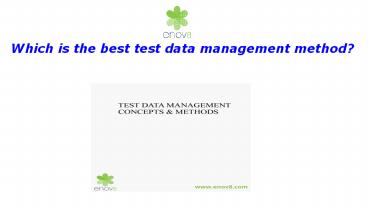Which is the best test data management method? - PowerPoint PPT Presentation
Title:
Which is the best test data management method?
Description:
First and foremost, you need to have a strong, highly-functional and efficient test data management strategy that functions perfectly and efficiently to reap all the benefits that it has to offer. – PowerPoint PPT presentation
Number of Views:33
Title: Which is the best test data management method?
1
Which is the best test data
management method?
2
- The test automation process is very crucial for
product tests and releases. It also can be the
prominent factor to build the trust and
credibility for your brand. - Well, first and foremost, you need to have a
strong, highly-functional and efficient test data
management strategy that functions perfectly and
efficiently to reap all the benefits that it has
to offer. - However, still, many software developers and
quality analysts don't have any ideas about how
to design and implement the test data management
strategy. - Even professionals who know about it, are
confused when it comes to choosing the right data
test management method for their products. Well,
multiple options will certainly put you in a
dilemma. - In this post, we will discuss some of these
methods and their unique strengths and weaknesses
to help you in the decision making process.
3
- Data replication from production
- This is the most popular and preferred approach,
especially among the beginners. When there is a
need for test data to feed in your testing
processes, copying data from production is not
just the most convenient thing, but it is also a
realistic approach. - Well, it is not as easy as it seems as there are
some drawbacks to this approach. - The first issue with the data replication
approach is the manual feeding of data into
testing processes. Now, you might argue that
there are scripts and automated jobs available to
do the heavy lifting, but data availability when
it is needed is also as much crucial as data
generation. - Relying on a native approach which is solely
based on scripts might not be efficient and
sufficient. It might force you to rely on the
manual process. - In addition to that, there is also a possibility
that this approach is not lending itself well
when it comes to negative test cases. - Negative testing is the scenario where the tests
validate the system against invalid data. You
cannot rely on this approach when you want to
test the system against negative testing.
4
- Also, if you want to test the product when it is
in the development process, it cannot be possible
with a data replication approach as there is no
data available in production to copy from. - Frequently testing the product at different
stages of development is the new technique with
many benefits. You can't do this with this
approach. - Last, but not the least, this approach might
abuse data and by doing so, fail the data
compliance rules and regulations. - You might face catastrophic legal, financial and
brand credibility consequences. - Data Masking
5
- The data masking method was developed to address
all the limitations of the data replication
approach. - Here, test data management tools will use this
approach by applying masks to production data. - These masks will remove all the personally
identifiable information from the data. - However, it appropriately deals with data
compliance restrictions of the precious data
replication approach, it too has some downsides. - First, the time this approach takes is even more
than the data replication approach. - Well, this is an issue when you need to release
the product quickly. - Furthermore, the data masking approach is not a
standalone approach as it just resolves one
downside of the data replication approach. - Just one downside, not all of them. Data masking
is not a solution if you want to develop a
product in the development stages with no
production data.
6
Synthetic data generation Here, fake or
synthetic test data is generated from a data
model that is then used for data testing. The
values are disconnected with any actual data and
tools can preserve the data format, but to
generate synthetic data out of nowhere, this
approach reduces the risks of exposing sensitive
data. However, the downside is you might end up
with data which is not similar to
production-like, which is the goal of a good TDM
strategy. Wrapping up There are some more
methods for test data management, some of them
are just variations and combinations of the
approaches we discussed here. Apart from
generating data, you also need to keep in the
mind data quality, data availability and security
too.
7
Contact Us
- Company Name Enov8
- Contact Person Ashley Hosking
- Address Level 5, 14 Martin Place, Sydney, 2000,
New South Wales, - Australia
- Email enov8australia_at_gmail.com
- Phone(s) 61 2 8916 6391
- Fax 61 2 9437 4214
- Website - https//www.enov8.com
8
Thank You































